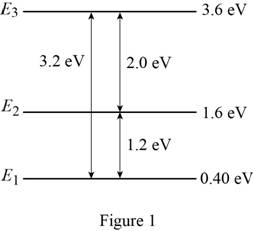
Concept explainers
(a)
The ground state energy of the electron
(a)
Answer to Problem 29P
The ground state energy of the electron is
Explanation of Solution
The energy of the emitted photon during the transition from first excited state to the ground state is
Write the expression for energy difference between ground state and first excited state
Here,
Write the relation between
Substituting (II) in (I) and substituting
Rearranging (III)
Conclusion:
Substituting
Thus, the ground state energy of the electron is
(b)
The possible energies of the photon when a downward transition occur starting from the second excited state.
(b)
Answer to Problem 29P
The possible energies of the emitted photons are
Explanation of Solution
When the electron starts from the first excited state, the possible downward transitions are
The transitions are given in the energy level diagram given below

Write the expression for energy of the emitted photon during transition
Here,
Substituting the corresponding values of
Thus, the possible energies of the emitted photons are
Conclusion
Substituting
Substituting
Substituting
Substituting
Thus, the possible energies of the emitted photons are
(c)
The length of the one dimensional box.
(c)
Answer to Problem 29P
The length of the box is
Explanation of Solution
The length of the box is
Write the expression for energy of a particle in a 1D box.
Here,
Rearranging (IX)
Conclusion:
Substitute,
Thus, the length of the box is
Want to see more full solutions like this?
Chapter 28 Solutions
Physics
- 3) If the slider block C is moving at 3m/s, determine the angular velocity of BC and the crank AB at the instant shown. (Use equation Vs Vc wxf, then use equation V, VA + Va/Athen write it in terms of w and the appropriate r equate the two and solve) f-3marrow_forwardPls help ASAParrow_forwardPls help ASAParrow_forward
- 14. A boy is out walking his dog. From his house, he walks 30 m North, then 23 m East, then 120 cm South, then 95 m West, and finally 10 m East. Draw a diagram showing the path that the boy walked, his total displacement, and then determine the magnitude and direction of his total displacement.arrow_forwardPls help ASAParrow_forwardPls help ASAParrow_forward
- Pls help ASAParrow_forwardPls help ASAParrow_forward12. A motorboat traveling 6 m/s, West encounters a water current travelling 3.5 m/s, South. a) Draw a vector diagram showing the resultant velocity, then determine the resultant velocity of the motorboat. b) If the width of the river is 112 m wide, then how much time does it take for the boat to travel shore to shore? c) What distance downstream does the boat reach the opposite shore?arrow_forward
- Lake Erie contains roughly 4.00⋅10114.00⋅1011 m3 of water. Assume the density of this water is 1000. kg/m3 and the specific heat of water is 4186 J/kg˚C. It takes 2.31x10^19 J of energy to raise the temperature of that volume of water from 12.0 °C to 25.8 ˚C. An electric power plant can produce about 1110 MW. How many years would it take to supply this amount of energy by using the 1110 MW from an electric power plant?arrow_forwardPls help ASAParrow_forwardPls help ASAParrow_forward
 College PhysicsPhysicsISBN:9781305952300Author:Raymond A. Serway, Chris VuillePublisher:Cengage Learning
College PhysicsPhysicsISBN:9781305952300Author:Raymond A. Serway, Chris VuillePublisher:Cengage Learning University Physics (14th Edition)PhysicsISBN:9780133969290Author:Hugh D. Young, Roger A. FreedmanPublisher:PEARSON
University Physics (14th Edition)PhysicsISBN:9780133969290Author:Hugh D. Young, Roger A. FreedmanPublisher:PEARSON Introduction To Quantum MechanicsPhysicsISBN:9781107189638Author:Griffiths, David J., Schroeter, Darrell F.Publisher:Cambridge University Press
Introduction To Quantum MechanicsPhysicsISBN:9781107189638Author:Griffiths, David J., Schroeter, Darrell F.Publisher:Cambridge University Press Physics for Scientists and EngineersPhysicsISBN:9781337553278Author:Raymond A. Serway, John W. JewettPublisher:Cengage Learning
Physics for Scientists and EngineersPhysicsISBN:9781337553278Author:Raymond A. Serway, John W. JewettPublisher:Cengage Learning Lecture- Tutorials for Introductory AstronomyPhysicsISBN:9780321820464Author:Edward E. Prather, Tim P. Slater, Jeff P. Adams, Gina BrissendenPublisher:Addison-Wesley
Lecture- Tutorials for Introductory AstronomyPhysicsISBN:9780321820464Author:Edward E. Prather, Tim P. Slater, Jeff P. Adams, Gina BrissendenPublisher:Addison-Wesley College Physics: A Strategic Approach (4th Editio...PhysicsISBN:9780134609034Author:Randall D. Knight (Professor Emeritus), Brian Jones, Stuart FieldPublisher:PEARSON
College Physics: A Strategic Approach (4th Editio...PhysicsISBN:9780134609034Author:Randall D. Knight (Professor Emeritus), Brian Jones, Stuart FieldPublisher:PEARSON





